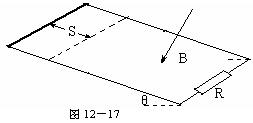问题
问答题
有足够长的平行金属导轨,电阻不计,导轨光滑,间距 .现将导轨沿与水平方向成
.现将导轨沿与水平方向成 角倾斜放置.在底部接有一个
角倾斜放置.在底部接有一个 的电阻.现将一个长为
的电阻.现将一个长为 、质量
、质量 、电阻
、电阻 的金属棒自轨道顶部沿轨道自由滑下,经一段距离后进入一垂直轨道平面的匀强磁场中(如图12-17所示).磁场上部有边界,下部无边界,磁感应强度
的金属棒自轨道顶部沿轨道自由滑下,经一段距离后进入一垂直轨道平面的匀强磁场中(如图12-17所示).磁场上部有边界,下部无边界,磁感应强度 .金属棒进入磁场后又运动了
.金属棒进入磁场后又运动了 后开始做匀速直线运动,在做匀速直线运动之前这段时间内电阻R上产生了
后开始做匀速直线运动,在做匀速直线运动之前这段时间内电阻R上产生了 的内能(
的内能( ).求:
).求:

(1)金属棒进入磁场后速度 时的加速度a的大小及方向;
时的加速度a的大小及方向;
(2)磁场的上部边界距顶部的距离S.
答案
(1) 方向为沿轨道向上;(2)32.5m
方向为沿轨道向上;(2)32.5m
(1)金属棒从开始下滑到进入磁场前由机械能守恒得:
进入磁场后棒上产生感应电动势 ,又有
,又有
金属棒所受的安培力沿轨道向上,大小为 
由牛顿第二定律得: 
整理得: 代入得:
代入得: 负号表示其方向为沿轨道向上.
负号表示其方向为沿轨道向上.
(2)设匀速运动时的速度为 ,金属棒做匀速运动时根据平衡条件得:
,金属棒做匀速运动时根据平衡条件得:
 即
即
自金属棒进入磁场到做匀速运动的过程中由能的转化与守恒得:
又有电功率分配关系

代入解得:S=32.5m
